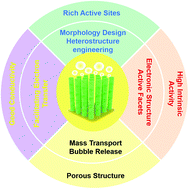Engineering transition metal catalysts for large-current-density water splitting†
Abstract
Electrochemical water splitting plays a crucial role in transferring electricity to hydrogen fuel and appropriate electrocatalysts are crucial to satisfy the strict industrial demand. However, the successfully developed non-noble metal catalysts have a small tested range and the current density is usually less than 100 mA cm−2, which is still far away from the practical application standards. Aiming to provide guidance for the fabrication of more advanced electrocatalysts with a large current density, we herein systematically summarize the recent progress achieved in the field of cost-efficient and large-current-density electrocatalyst design. Beginning by illustrating the oxygen evolution reaction (OER) and hydrogen evolution reaction (HER) mechanisms, we elaborate on the concurrent issues of non-noble metal catalysts that are required to be addressed. In view of large-current-density operating conditions, some distinctive features with regard to good electrical conductivity, high intrinsic activity, rich active sites, and porous architecture are also summarized. Next, some representative large-current-density electrocatalysts are classified. Finally, we discuss the challenges associated with large-current-density water electrolysis and future pathways in the hope of guiding the future development of more efficient non-noble-metal catalysts to boost large-scale hydrogen production with less electricity consumption.

- This article is part of the themed collection: 2022 Frontier and Perspective articles


 Please wait while we load your content...
Please wait while we load your content...